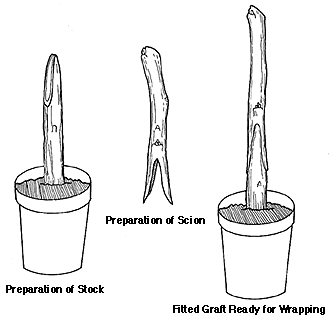Saddle Graft
Saddle grafting is a relatively easy technique
to learn and
once mastered can be performed quite rapidly. The stock may be either
field-grown or potted. Both rootstock and scion should be the same
diameter. For best results, use saddle grafting on dormant stock in
mid- to late winter. Stock should not be more than 1 inch in diameter.

Preparing the
Stock
Using two opposing upward strokes of the grafting
knife, sever the top from the rootstock. The resulting cut should
resemble an inverted V, with the surface of the cuts ranging from 1/2
to 1 inch long.
Preparing
the Scion
Now reverse the technique to
prepare the base of the scion. These cuts on the rootstock and scion
must be the same length and have the same slope so that a maximum
amount of cambial tissue will make contact when the two halves are
joined.
Inserting the
Scion
Place the V-notched scion onto the saddle
of the rootstock. If rootstock and scion are the same diameter, cambial
alignment is easier; otherwise adjust as needed.
Securing the Graft
Wrap the graft with a grafting twine, tape, or strip, then seal it with
grafting wax or grafting paint.
Back to
Grafting
Techniques Page
|
